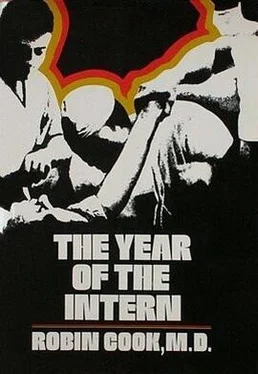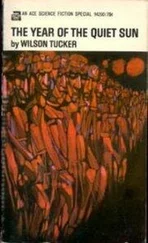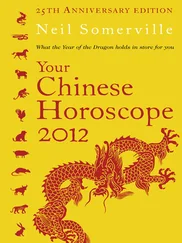I had had the same sensation several times. Once, during a high-school football scrimmage, I had been hurled onto a pile-up just as a guy broke his leg with an audible crunch, the leg bending off at an angle below his knee. Although he wasn’t in much pain, the rest of us were panic-stricken, and, true to stereotype, I tried to get him to drink some water. I think that at that moment I set out unconsciously on the road to med school. The idea of knowing what to do, of satisfying an urge to act, was overpowering.
So, all right, Peters, now you’re a doctor — do something for Roso. Right, the Sparine it would be, and the second I made that decision, the happiness of positive, directed action flooded over me.
“Roso, I make you sleep you feel more strong.”
As I sat down at the nurses’ station, the almond-eyed nurse slid Roso’s chart across to me. She looked even prettier than she had before. “Are you Chinese?” I asked, not looking at her.
“Chinese and Hawaiian. My grandfather on my mother’s side was Hawaiian.”
I thought it would be fun to get to know her. “How come you live at home?”
No answer to that. Well, the hell with it. I opened the chart to write the Sparine order. Too bad, though. She looked like all the girls I had expected to see under Hawaiian waterfalls. Only I hadn’t been outside the hospital long enough at that point to see any waterfalls, and my sex life, if you could call it that, was restricted to Jan. Would she still be there, even at midnight?
I’d better get the hell out of here, I thought, as I wrote “Sparine 100 mg. IM stat,” put a marker in the chart to indicate a new order, and tossed it on the counter. Roso would sleep. The last time I gave him 100 mg. he was out for eighteen hours.
“Doctor, as long as you are here” — the fateful, familiar question — “would you mind seeing a man with a cast, and also the quadriplegic?” I knew the quadriplegic, but not the man with the cast.
“What’s wrong with the cast?” I asked with some hesitation, fearing a request for a new cast at that hour.
“He says it cuts into his back when he moves.”
“And the quadriplegic?”
“He refuses to take his antibiotic.”
Actually, I hadn’t really wanted an answer to that question. Paralyzed people caused me about as much psychic distress as those with tuberculosis. My mind went back to the most attractive building and the most depressing service in medical school, neurosurgery and neurology. I remembered examining one patient who answered my questions as I stuck him with a pin. He had seemed so normal I almost wondered why he was in the hospital until, when I pricked him again, his eyes suddenly disappeared into his head and the right side of his body stiffened, pushing him onto his left side and nearly, rolling him off the bed. All I could see were the whites of his eyes, and I was as paralyzed as he was, not knowing what the hell to do. There wasn’t even the satisfaction of running for a glass of water. The patient was only having a convulsion, but I didn’t know that then. He could have been dying, and I would have stood there with my mouth hanging open. No one outside the medical world can know what a crisis like that means to a medical student. You get so gun shy that you try not to be around when something goes wrong.
Neurology students were expected to stand with hands in pockets enjoying the professor’s elegant diagnosis: “Some of the spinal pathways cross over before running to the brain. Others don’t. If you have a lesion effectively cutting off one side of the spinal cord, the tracts that cross will still work. Here, notice how this patient is able to feel this temperature change but cannot have any proprioceptive sense, because I can move the toe in any direction without his being conscious of it.” And so it went.
Everybody had a ball discussing those tricky little temperature fibers crossing over in the ventral white commissure and running up the lateral spinothalamic tract to the posterolateral ventral nucleus of the thalamus. Great arguments erupted over whether fibers were unmyelinated or myelinated. No field of medicine can match neurology for high-flown jargon. Meanwhile, nobody thought much about the patient. Well, you hardly had time, trying to remember all those tracts and nuclei, and besides, you couldn’t do anything, anyway.
Perhaps it was this lack of possibility that made paralysis cases so hard for me to handle emotionally. I particularly remembered one neurology case in medical school, although it was not unusual; in fact, it was a fairly typical case. The patient had lain before us in a respirator, his facial muscles moving constantly. Nothing else about him moved: he could control nothing else because the rest of him was a pile of immobile, unfeeling tissue and bone, completely helpless and totally dependent on the respirator for life. The professor had been saying, “You will find this an extremely interesting case, gentlemen, a fracture of the odontoid process, which caused the spinal cord to be severed just at the point where it comes out of the head.” The professor was loving it. His diagnostic triumph had been accomplished, he proudly told us, only after a delicate X-ray procedure through the mouth. Then he was off, puffed like a pigeon and virtually cooing, into a long discussion of how the atlas had been dislocated from the axis.
I had not been able to take my eyes off the patient, who was staring fixedly into the mirror just over his head. About my age and a hopeless case. To know that his body and mine were essentially the same, that the only difference was a tiny disconnection deep in his neck and that this fractional difference was total, had made me conscious of my body at that moment as never before, and ashamed of it. Just then I had felt hunger, my fingertips, a backache, sensations he would never have again. I was filled with helpless rage and a kind of heartsickness. Movement is so much a part of living, almost life itself, that from day to day normal people deny this kind of death. Yet here in front of me was death in life, and my mind was screaming at me that my own body hung on the same fragile string that lay broken there under the respirator. Many times since, in the dark moments, I had thought that the morbidity in medicine made it the wrong road for me, but I kept at it. Do other doctors have such doubts?
For now, however, the man with the cast came first; I’d see the quadriplegic later. I got a cutter out of the closet and walked down the hall with the nurse. Turning into the room, we came upon a man in a gigantic spica cast extending from his navel all the way down his right leg to the toes. The left leg was free. That morning, he had fractured his femur about midway between groin and knee, and the cast had been put on right away. As usual on the first day in such a constricting mold, the man was excruciatingly uncomfortable. I found the edge that was bothering him and began to cut pieces away. It would have been quicker with the power cutter from the emergency room, but midnight is the wrong time for a tool that sounds like a chain saw. Besides, the vibration always scared the patient half to death, despite all your assurances that the power cutter vibrated very rapidly and therefore would cut only something stiff, not soft like skin. He would seem to understand until the cutter whined into action, knifing easily through the rock-hard plaster. I finished my cutting, and the fractured-femur case lay back with a sigh of relief, gratefully moving from side to side. “Much better, Doctor. Thank you very much.”
Simple things like that make you feel good. Of course, anybody off the street could have cut away the offending piece, but no matter. To know that the man would rest easily now somehow justified me and made my being there worth while. I was learning that an intern is not often allowed to make patients more comfortable. He is usually hurting them, sticking needles into them, putting tubes up their noses, coaxing a cough after an operation to force them to fully expand their lungs. That cough is especially hard and painful for chest cases. In chest surgery, it is a common procedure for the surgeon to split the breastbone down the middle, and wire it together again at the end of the operation. Four or five hours later, it was my job to cram a small tube down the patient’s windpipe, irritating the membrane to force a full cough. The method was foolproof. Like anyone with something in his trachea, the patient invariably coughed, thinking halfway through that the convulsion would tear him apart, trying to stop but not being able to, and finally subsiding, sweat-soaked and exhausted, as I pulled the tube out. In the long run I had perhaps helped the patient avoid pneumonia or worse, but in the short run I had put him through hell. So making the man with the cast more comfortable was not to be lightly regarded.
Читать дальше












